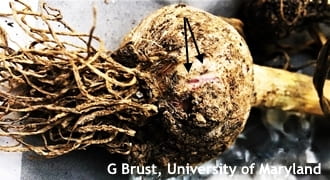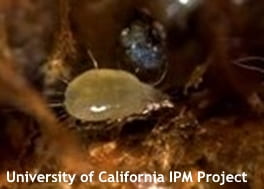Jerry Brust, IPM Vegetable Specialist, University of Maryland; jbrust@umd.edu
Bulb mites (usually Rhizoglyphus spp) are a problem of garlic that easily go unrecognized. Usually growers notice a general yellowing of their garlic plants with the tips of leaves often turning brown (Fig. 1). If you examine the bulb it can have feeding marks on the outside of the bulb (Fig. 2) or the basal plate can separate easily from the bulb (Fig. 3). The best way to determine whether these mites are present is to carefully dissect the region where the roots and bulb come together. There are usually other mites present, but with a hand lens the bulb mites usually can be identified from other mites. The mite is bulb shaped with its legs moved forward and a bulbous rear end and many long fine hairs (Fig. 4). The mouthparts and legs are purplish-brown while the main body is creamy white. The mites are extremely small (from 0.02 to 0.04 inches) and are very slow moving. They are usually found in clusters underneath scales and at the base of the roots.
Early in the growing season, bulb mites can cause poor plant stands and stunted growth as they feed on the plants. Infested plants easily can be pulled out of the soil because of the poor root growth. Later in the season, greater than normal amounts of Botrytis or soft rot or Fusarium dry rot may be seen because of the wounds caused by these mites. In some cases, garlic that became infested with bulb mites was grown in new fields that never had any Allium species in it (usually it is new bulbs in an infested field). But bulbs were saved from last year’s garlic harvest and used in the new soil and some of them were infested with the mites. Be sure to start with clean fields and clean bulbs as there is little chemically that can be done for control. If you find you have bulb mites in your harvested bulbs that you intend to use next year you can hot water treat the garlic seed but this will decrease germination. Put the seed in water heated to 130°F 10-20 minutes or you can soak the seed for 24 hours in a 2% soap (don’t use detergent) and 2% mineral oil solution before planting.
Figure 1. Garlic plants with early signs of root/bulb problems
Figure 2. Garlic bulb with feeding damage from bulb mites
Figure 3. Roots separate easily from garlic bulb
Figure 4. Bulb mite on garlic




